Basic Math & Pre-Algebra For Dummies, 2nd Edition (2014)
Part IV. Picturing and Measuring - Graphs, Measures, Stats, and Sets
Chapter 18. Solving Geometry and Measurement Word Problems
IN THIS CHAPTER
Solving measurement problems using conversion chains
Using a picture to solve geometry problems
In this chapter, I focus on two important types of word problems: measurement problems and geometry problems. In a word problem involving measurement, you’re often asked to perform a conversion from one type of unit to another. Sometimes you don’t have a conversion equation to solve this type of problem directly, so you need to set up a conversion chain, which I discuss in detail later in the chapter.
Another common type of word problem requires the geometric formulas that I provide in Chapter 16. Sometimes a geometry word problem gives you a picture to work with. In other cases, you have to draw the picture yourself by reading the problem carefully. Here I give you practice doing both types of problems.
The Chain Gang: Solving Measurement Problems with Conversion Chains
In Chapter 15, I give you a set of basic conversion equations for converting units of measurement. I also show you how to turn these equations into conversion factors — fractions that you can use to convert units. This information is useful as far as it goes, but you may not always have an equation for the exact conversion that you want to perform. For example, how do you convert years to seconds?
For more-complex conversion problems, a good tool is the conversion chain. A conversion chain links together a sequence of unit conversions.
Setting up a short chain
Here’s a problem that shows you how to set up a short conversion chain to make a conversion you won’t find a specific equation for:
Vendors at the Fragola County Strawberry Festival sold 7 tons of strawberries in a single weekend. How many 1-ounce servings of strawberries is that?
You don’t have an equation to convert tons directly to ounces. But you do have one to convert tons to pounds and another to convert pounds to ounces. You can use these equations to build a bridge from one unit to another. So here are the two equations you want to use:
![]()
To convert tons to pounds, note that these fractions equal 1 because the numerator (top number) equals the denominator (bottom number):
![]()
To convert pounds to ounces, note that these fractions equal 1:
![]()
You could do this conversion in two steps. But when you know the basic idea, you can set up a conversion chain instead to get from tons to ounces:
![]()
So here’s how to set up a conversion chain to turn 7 tons into pounds and then into ounces. Because you already have tons on top, you want the tons-and-pounds fraction that puts ton on the bottom. And because that fraction puts pounds on the top, use the pounds-and-ounces fraction that puts pound on the bottom:
![]()
The net effect here is to take the expression 7 tons and multiply it twice by 1, which doesn’t change the value of the expression. But now you can cancel out all units of measurement that appear in the numerator of one fraction and the denominator of another:
![]()
 If any units don’t cancel out properly, you probably made a mistake when you set up the chain. Flip the numerator and denominator of one or more of the fractions until the units cancel out the way you want them to.
If any units don’t cancel out properly, you probably made a mistake when you set up the chain. Flip the numerator and denominator of one or more of the fractions until the units cancel out the way you want them to.
Now you can simplify the expression:
![]()
 A conversion chain doesn’t change the value of the expression — just the units of measurement.
A conversion chain doesn’t change the value of the expression — just the units of measurement.
Working with more links
When you understand the basic idea of a conversion chain, you can make a chain as long as you like to solve longer problems easily. Here’s another example of a problem that uses a time-related conversion chain:
Jane is exactly 12 years old today. You forgot to get her a present, but you decide that offering her your mathematical skills is the greatest gift of all — you’ll recalculate how old she is. Assuming that a year has exactly 365 days, how many seconds old is she?
Here are the conversion equations you have to work with:
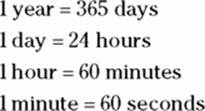
To solve this problem, you need to build a bridge from years to seconds, as follows:
![]()
So set up a long conversion chain, as follows:
![]()
Cancel out all units that appear in both a numerator and a denominator:
![]()
 As you cancel out units, notice that there is a diagonal pattern: The numerator (top number) of one fraction cancels with the denominator (bottom number) of the next, and so on.
As you cancel out units, notice that there is a diagonal pattern: The numerator (top number) of one fraction cancels with the denominator (bottom number) of the next, and so on.
When the smoke clears, here’s what’s left:
![]()
This problem requires a bit of multiplication, but the work is no longer confusing:
= 378,432,000 sec.
The conversion chain from 12 years to 378,432,000 seconds doesn’t change the value of the expression — just the unit of measurement.
Pulling equations out of the text
In some word problems, the problem itself gives you a couple of the conversion equations necessary for solving. Take this problem, for example:
A furlong is ![]() of a mile, and a fathom is 2 yards. If I rode my horse 24 furlongs today, how many fathoms did I ride?
of a mile, and a fathom is 2 yards. If I rode my horse 24 furlongs today, how many fathoms did I ride?
This problem gives you two new conversion equations to work with:
· 1 furlong = 1/8 mile
· 1 fathom = 2 yards
It’s helpful to remove fractions from the equations before you begin, so here’s a more useful version of the first equation:
![]()
You also want to remember two other conversions:
![]()
Next, build a bridge from furlongs to miles using the conversions available from these equations:
![]()
Now you can form your conversion chain. Every unit you want to cancel has to appear once in the numerator and once in the denominator:
![]()
Next, you can cancel out all the units except for fathoms:
![]()
Another way you can make this problem a little easier is to notice that the number 24 is in the numerator and 3 and 8 are in the denominator. Of course, 3 × 8 = 24, so you can cancel out all three of these numbers:
![]()
At this point, the expression has only two numbers left aside from the 1s, and the fraction’s easy to simplify:
![]()
As always, the conversion chain from 24 furlongs to 2,640 fathoms doesn’t change the value of the expression — just the units of measurement.
Rounding off: Going for the short answer
Sometimes real-life measurements just aren’t that accurate. After all, if you measure the length of a football field with your trusty ruler, you’re bound to be off an inch or two (or more). When you perform calculations with such measurements, finding the answer to a bunch of decimal places doesn’t make sense because the answer’s already approximate. Instead, you want to round off your answer to the numbers that are probably correct. Here’s a problem that asks you to do just that:
Heather weighed her new pet hamster, Binky, and found that he weighs 4 ounces. How many grams does Binky weigh, to the nearest whole gram?
This problem requires you to convert from English to metric units, so you need this conversion equation:
![]()
Notice that this conversion equation includes only kilograms and pounds, but the problem includes ounces and grams. So to convert from ounces to pounds and from kilograms to grams, here are some equations to help build a bridge between ounces and grams:
![]()
Your chain will perform the following conversions:
![]()
So set up your expression as follows:
![]()
As always, after you set up the expression, you can cancel out every unit except for the one you’re converting to:
![]()
 When you’re multiplying a string of fractions, you can make one fraction out of all the numbers. The numbers that were originally in the numerators of fractions remain in the numerator. Similarly, the numbers that were in the denominators remain in the denominator. Then just put a multiplication sign between each pair of numbers.
When you’re multiplying a string of fractions, you can make one fraction out of all the numbers. The numbers that were originally in the numerators of fractions remain in the numerator. Similarly, the numbers that were in the denominators remain in the denominator. Then just put a multiplication sign between each pair of numbers.
![]()
At this point, you can begin calculating. But to save some effort, I recommend canceling out common factors. In this case, you cancel out a 4 in the numerator and denominator, changing the 16 in the denominator to a 4:
![]()
Now you can cancel out another 4 in the numerator and denominator, changing the 1,000 in the numerator to 250:
![]()
At this point, here’s what’s left:
![]()
Divide 250 by 2.2 to get your answer:
![]()
Notice that I took the division out to one decimal place. Because the number after the decimal point is 6, I need to round up my answer to the next highest gram. (See Chapter 11 for more about rounding decimals.)
So to the nearest gram, Binky weighs 114 grams. As usual, the conversion chain doesn’t change the value of the expression — just the unit of measurement.
Solving Geometry Word Problems
Some geometry word problems present you with a picture. In other cases, you have to draw a picture yourself. Sketching figures is always a good idea because it can usually give you an idea of how to proceed. The following sections present you with both types of problems. (To solve these word problems, you need some of the geometry formulas I discuss in Chapter 16.)
Working from words and images
Sometimes you have to interpret a picture to solve a word problem. Read the problem carefully, recognize shapes in the drawing, pay attention to labels, and use whatever formulas you have to help you answer the question. In this problem, you get to work with a picture.
Mr. Dennis is a farmer with two teenage sons. He gave them a rectangular piece of land with a creek running through it diagonally, as shown in Figure 18-1. The elder boy took the larger area, and the younger boy took the smaller. What is the area of each boy’s land in square feet?
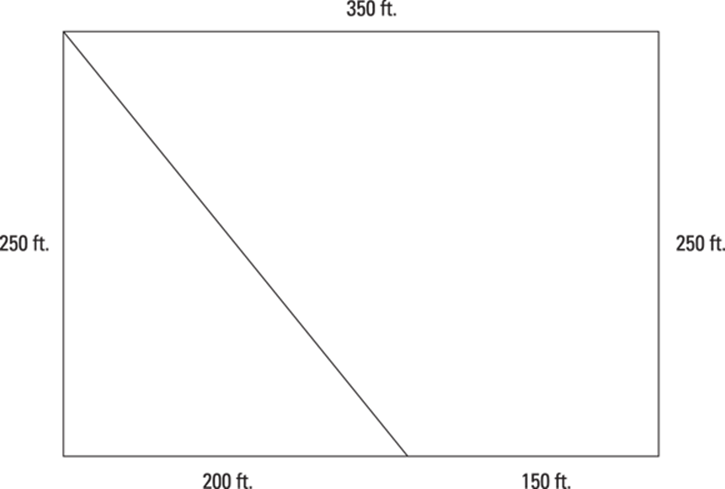
© John Wiley & Sons, Inc.
FIGURE 18-1: Two sons get nonrectangular portions of a rectangular field.
To find the area of the smaller triangular plot, use the formula for the area of a triangle, where A is the area, b is the base, and h is the height:
![]()
The whole piece of land is a rectangle, so you know that the corner the triangle shares with the rectangle is a right angle. Therefore, you know that the sides labeled 200 feet and 250 feet are the base and height. Find the area of this plot by plugging the base and height into the formula:
![]()
To make this calculation a little easier, notice that you can cancel a factor of 2 from the numerator and denominator:
![]()
The shape of the remaining area is a trapezoid. You can find its area by using the formula for a trapezoid, but there’s an easier way. Because you know the area of the triangular plot, you can use this word equation to find the area of the trapezoid:
area of trapezoid = area of whole plot – area of triangle
To find the area of the whole plot, remember the formula for the area of a rectangle. Plug its length and width into the formula:

Now just substitute the numbers that you know into the word equation you set up:
![]()
So the area of the elder boy’s land is 62,500 square feet, and the area of the younger boy’s land is 25,000 square feet.
Breaking out those sketching skills
Geometry word problems may not make much sense until you draw some pictures. Here’s an example of a geometry problem without a picture provided:
In Elmwood Park, the flagpole is due south of the swing set and exactly 20 meters due west of the treehouse. If the area of the triangle made by the flagpole, the swing set, and the treehouse is 150 square meters, what is the distance from the swing set to the treehouse?
This problem is bound to be confusing until you draw a picture of what it’s telling you. Start with the first sentence, depicted in Figure 18-2. As you can see, I’ve drawn a right triangle whose corners are the swing set (S), the flagpole (F), and the treehouse (T). I’ve also labeled the distance from the flagpole to the tree house as 20 meters.
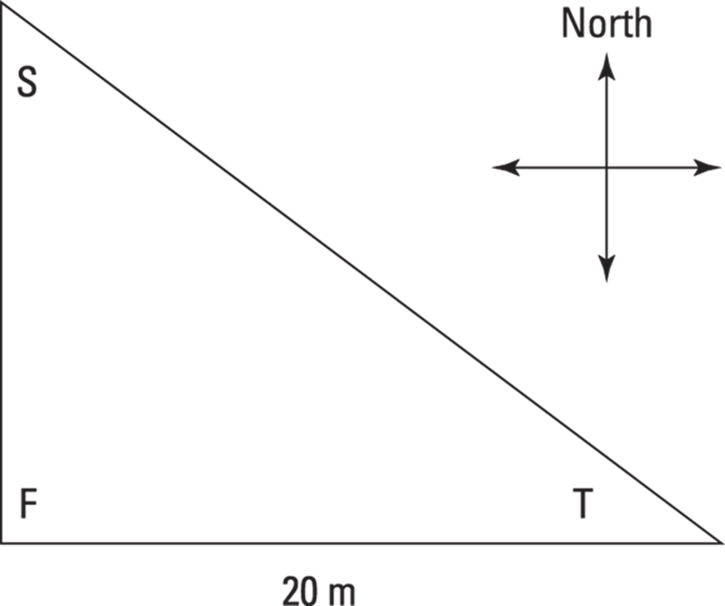
© John Wiley & Sons, Inc.
FIGURE 18-2: A labeled sketch shows the important information in a word problem.
The next sentence tells you the area of this triangle:
![]()
Now you’re out of information, so you need to remember anything you can from geometry. Because you know the area of the triangle, you may find the formula for the area of a triangle helpful:
![]()
Here b is the base and h is the height. In this case, you have a right triangle, so the base is the distance from F to T, and the height is the distance from S to F. So you already know the area of the triangle, and you also know the length of the base. Fill in the equation:
![]()
You can now solve this equation for h. Start by simplifying:
![]()
Now you know that the height of the triangle is 15 meters, so you can add this information to your picture (see Figure 18-3).
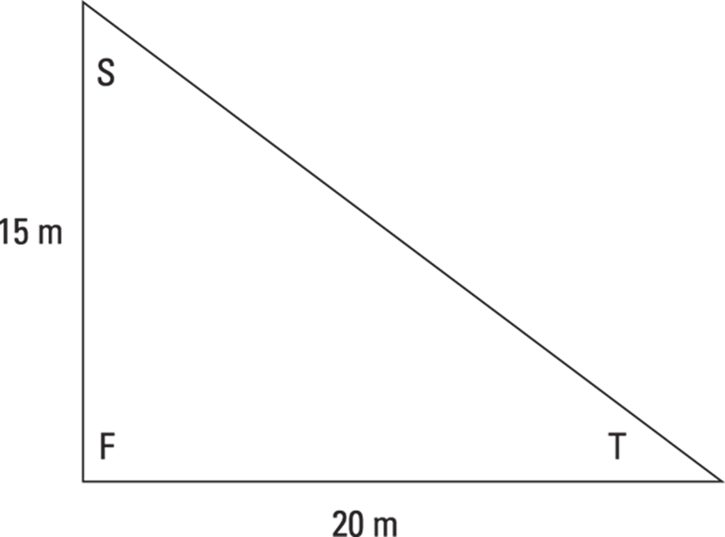
Illustration by Wiley, Composition Services Graphics
FIGURE 18-3: Update the labels in your sketch as you work through the problem.
To solve the problem, though, you still need to find out the distance from S to T. Because this is a right triangle, you can use the Pythagorean theorem to figure out the distance:
![]()
Remember that a and b are the lengths of the short sides, and c is the length of the longest side, called the hypotenuse. (See Chapter 16 for more on the Pythagorean theorem.) You can substitute numbers into this formula and solve, as follows:
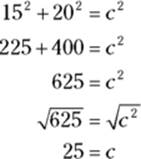
So the distance from the swing set to the treehouse is 25 meters.